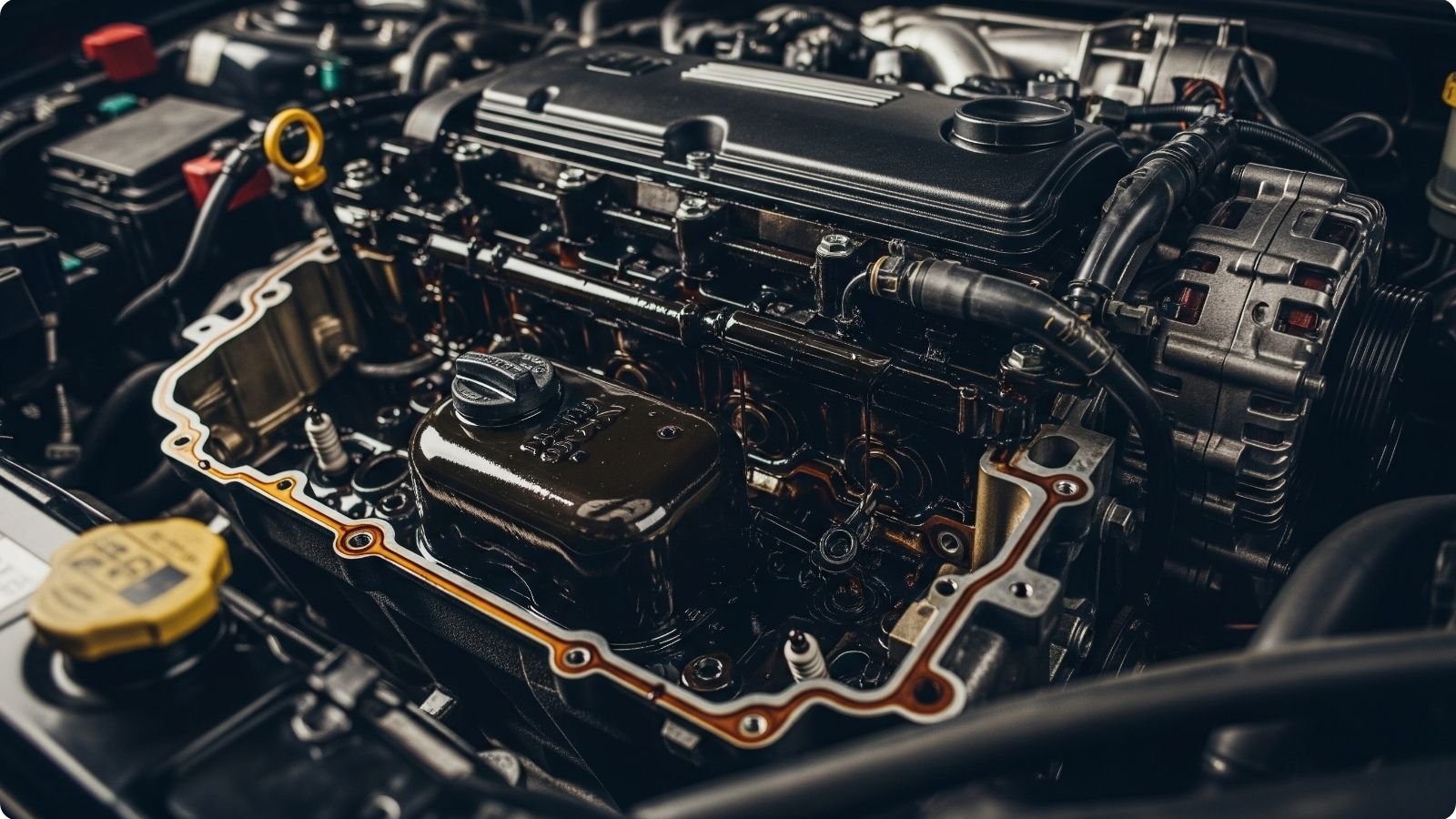Can Too Much Oil Cause Car Not to Start?

It was a Sunday morning. I had plans. Sunlight was peeking through the garage as I turned the key—click. Nothing. Silence. No rumble. Just a big sigh and a hint of panic. Could it be the battery? Maybe the starter? Then a thought popped up—did I overfill the oil yesterday?
If you’re like me, you probably thought more oil = better protection. But that’s not always true. In fact, can too much oil cause car not to start? That’s what we’re here to uncover, and you’ll be surprised at how something that seems helpful can turn against your engine.
This article is your guide to understanding how too much oil affects your car, and more importantly, how to fix and avoid it. You’ll find relatable stories, helpful facts, and simple steps in plain English. Ready? Let’s open the hood.
The Role of Engine Oil: Lifeblood of Your Car

When you overfill your oil, the crankshaft (a fast-spinning engine part) comes in contact with it. That stirs the oil like a blender, mixing it with air and turning it foamy. And foamy oil isn’t good at protecting metal parts.
That bubbly mess causes oil starvation—ironic, isn’t it? Too much oil ends up acting like there’s too little.
Here’s what can go wrong:
-
Foamy oil loses lubrication power.
-
Pressure builds up and causes leaks or gasket failure.
-
Spark plugs get drenched in oil and stop sparking.
And all these things? Yep—they can stop your engine from starting.
Can Too Much Oil Cause Car Not to Start? Absolutely—Here’s Why
Let’s be blunt. Yes, too much oil can cause a car not to start. And not in a small way either.
Here’s a breakdown of what happens inside the engine:
| Component Affected | How It Reacts to Excess Oil | What That Means for You |
|---|---|---|
| Spark Plugs | Get fouled by oil | Misfires, no spark, engine won’t start |
| Crankshaft | Whips oil into foam | Oil loses effectiveness |
| Catalytic Converter | May get clogged by burnt oil | Poor exhaust flow, reduced performance |
| Pistons | Face higher pressure | Stress, possible engine damage |
If you’re noticing:
-
A burning oil smell
-
Oil leaks near the engine
-
White smoke from the tailpipe
-
Sluggish or no startup
…then oil overflow might be your issue.
In many cases, your car won’t start because the spark plugs can’t fire. They’re soaked in oil. The engine tries to turn over, but there’s no spark to get it going.
A Personal Story: How I Learned the Hard Way
A few years back, I was getting ready for a road trip. Checked the oil. It looked low, so I added a bit. Then a bit more. I figured, “better safe than sorry.”
But when I tried to start the car—nothing.
What followed was a panic-driven YouTube binge, calls to my mechanic cousin, and finally, draining the excess oil in the middle of my driveway.
Turns out I had added a full quart too much. My spark plugs were swimming in oil. Once I cleaned them and got the level right? My car started like nothing ever happened.
Lesson learned: too much oil isn’t just messy—it’s a mood killer.
Signs You’ve Overfilled Your Engine Oil
Sometimes it’s not obvious. Your car won’t shout “TOO MUCH OIL!” So, you need to read the signs:
-
Dipstick reading above MAX line
Check when the engine’s cool, and the car’s on level ground. -
Engine knocking or sluggish performance
Too much pressure = unhappy parts. -
Blue smoke from the exhaust
That’s oil burning where it shouldn’t be. -
Check Engine Light comes on
Modern cars know something’s wrong even before you do. -
Oil-covered spark plugs
This one’s a common startup killer.
If you’ve just topped off your oil and your car won’t start afterward, connect the dots—it might be time to take a closer look at that dipstick.
Why Mechanics Always Say “Don’t Overfill”
It’s not just them being picky. Mechanics see the damage every day.
Overfilled engines can:
-
Damage oxygen sensors
-
Destroy catalytic converters
-
Cause seals and gaskets to fail
-
Lead to full-blown engine replacements
A $30 oil change can become a $3000 repair job if you don’t stop at the line.
And yes—too much oil can cause car not to start, but it can also ruin your engine in the long run.
So when your mechanic sighs and says, “Looks like someone added too much oil,” now you’ll know why.
Fixing the Problem: What to Do If You Overfill
Okay. So, you think you’ve overfilled. Your car won’t start. What now?
Here’s a simple step-by-step to fix it:
Tools You’ll Need:
-
Oil pan
-
Wrench or socket set
-
Clean rags
-
Funnel
-
New oil filter (maybe)
Steps to Follow:
-
Wait for the engine to cool
Hot oil = burns. -
Check the dipstick
Confirm how much over the line you are. -
Loosen the drain plug just slightly
Let a small amount drain into the pan. Go slowly. -
Recheck the level
Keep checking after each little drain. -
Replace the plug, wipe it down
Clean everything before you try starting the engine again. -
Try starting your car
Still won’t start? You might need to clean or replace spark plugs.
Cleaning Spark Plugs After Oil Overfill: The Overlooked Step
So, you’ve drained the excess oil and your dipstick looks perfect now—but your engine still won’t turn over. What gives?
Well, that extra oil may have already fouled your spark plugs. When plugs are coated in oil, they can’t ignite the fuel-air mixture. It’s like trying to light a wet match. The engine cranks, but there’s no spark—so it doesn’t start.
Here’s how to handle it:
-
Remove the spark plugs carefully
-
Inspect them for black, oily residue
-
Clean them with a wire brush or replace if too damaged
-
Dry them thoroughly before reinstalling
Even if you’re not a DIY enthusiast, a simple plug check can save you time and money. You don’t always need a mechanic to handle this step—especially if you’re familiar with a wrench and have a bit of patience.
Remember, too much oil can cause car not to start even after you’ve corrected the oil level—because the spark plugs stay affected until they’re cleaned or replaced.
Prevention Tips: How to Avoid Overfilling Engine Oil Again
Once you’ve been through an overfill nightmare, you’ll never want a repeat. So how do you avoid it?
Here are some golden rules to follow:
-
Always check oil levels with the engine cool
Warm oil expands and gives a false reading. -
Use the correct oil grade and capacity
Your owner’s manual is your best friend here. -
Top up slowly
Pour in small amounts, then wait a few seconds to let it settle. -
Don’t rely solely on guesswork
Use the dipstick. It’s there for a reason. -
Let the car sit on level ground before checking oil
Sloped surfaces can mess with readings.
Follow these tips, and you’ll keep your car happy, clean, and starting on the first turn—every time.
How Much Is Too Much? A Quick Look
You might be wondering, “How much over the limit is too much?”
Here’s a quick chart to help guide you:
| Overfill Level | Risk Level | Possible Effects |
|---|---|---|
| Up to ¼ inch over | Low | Minor issues, often safe |
| ½ inch to 1 inch | Moderate | Oil foaming, poor startup, possible plug fouling |
| 1 inch+ over | High | No start, oil leaks, internal damage |
So yes—just a bit too much oil might still allow the car to run, but anything beyond that becomes a real problem.
Even 1 extra quart on certain engines can be a disaster. It’s like adding one extra spoonful of salt to a perfectly cooked meal—there’s no going back without major work.
Real-World Scenarios: When It Happens to Others
Let me tell you what happened to my friend Imran.
He drives an old Toyota Corolla, the kind that’s been through floods, dents, and family road trips. One day, he calls me: “Bro, my car just won’t start. I changed the oil yesterday—added a little more just to be safe.”
Boom. There it was. I didn’t even need to ask how much he added—he’d dumped in almost two quarts extra. After draining, cleaning plugs, and some cursing under the hood, the engine roared back.
He still brings it up whenever we talk about car maintenance.
Stories like this are everywhere. You’re not alone if you’ve made the mistake. The trick is learning from it and moving forward smarter.
Key Takeaways to Remember
Let’s wrap up the knowledge bomb with a quick-fire list of what we’ve learned:
-
Yes, too much oil can cause your car not to start.
-
Oil foam kills lubrication and damages spark plugs.
-
Spark plugs soaked in oil won’t ignite fuel properly.
-
Overfilled engines can cause leaks, smoke, and long-term damage.
-
Draining excess oil and cleaning plugs can fix the problem.
-
Prevention is simple—slow pouring, accurate reading, and patience.
-
Never guess—check the dipstick every time.
FAQs: Clearing Up Common Questions
1. How much oil is too much for a car?
Even half a quart over can cause problems in some cars. Use the dipstick and your car’s manual to guide you. Never assume more is better.
2. Can overfilling oil blow a head gasket?
It’s rare, but possible. High internal pressure from too much oil can stress seals, including the head gasket. Not worth the risk.
3. How do I know if my spark plugs are affected by too much oil?
If your engine cranks but doesn’t start, and you recently added oil, check the plugs. Oily tips, black gunk, or a fuel smell are red flags.
4. Can I drive with slightly too much oil?
It depends on how “slight” it is. If it’s just above the full line, you might be okay. If it’s significantly above, drain some immediately.
5. Can I use an oil extractor to fix overfilling?
Yes! Oil extractors make it easy to remove small amounts from the top via the dipstick tube without crawling under the car.
6. Will an oil change fix the starting problem?
Often, yes. If the issue is oil overfill, a proper drain and plug clean can fix it. But don’t forget to inspect the spark plugs too.
7. Why does my engine shake after overfilling oil?
Excess oil may disrupt combustion or clog air pathways, causing rough idling or misfires. Drain it and have your engine inspected.
8. How long can you drive with too much oil before damage happens?
Not long. Sometimes, it only takes a few miles before permanent damage starts. If you suspect overfilling, stop driving and check immediately.
Final Thoughts: Oil Is Essential, But Balance Is Everything
In life, too much of a good thing can be bad. Same goes for engine oil.
Adding oil feels like love—you want your engine protected, safe, and smooth. But even love needs boundaries. Can too much oil cause car not to start? Absolutely. And now you know why, how to spot it, and how to fix it like a pro.
Whether you’re a seasoned car enthusiast or just learning your way around a dipstick, the key is balance. Treat your engine like a trusted friend—it’ll take care of you if you take care of it.
So next time you top off, remember: more isn’t always better. It’s about just enough.






